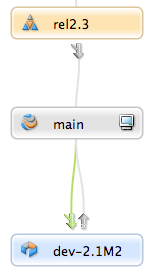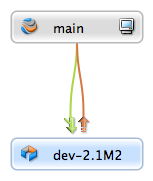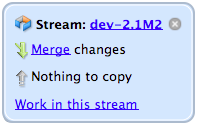Open topic with navigation
Using the stream graph
The Streams tab lists streams while the Stream Graph tab displays a graphical representation of the
relationships between parent and child streams in a selected depot.
To display streams in the Streams tab:
- Go to View > Streams to open the Streams tab.
-
Select a display option by clicking the Show streams in list or tree icon  :
:
- List displays the streams in a flat list.
- Tree (default) displays the streams in a hierarchy, with development
streams and release streams listed under mainline streams.
-
Search for streams or restrict the streams that are displayed by
using the Filter pane at the top of
the tab. You can filter by owner, stream name, parent stream,
stream type, and depot.
For more information about filters, see
Searching and filtering.
To display streams in the Stream graph:
- Go to View > Stream Graph to open the Stream Graph tab.
Stream Graph display conventions
The Stream Graph provides a graphical view of stream
relationships and provides tools and shortcuts for working with
streams.
The graph uses location and color to depict stream types: mainline
streams are gray and placed in the middle of the graph, release streams
are orange and appear above the mainline, and development streams are
blue and appear below.
Status indicators between streams tell you which streams have changes to
contribute and where the changes can be copied or merged:
Merge indicator:

Copy indicator:

The arrows are color-coded to indicate status:
- Gray: no merge or copy required
- Green: a merge or copy operation is available
- Orange: stream must be updated, after which merge or copy is
available
For example, the following arrows above the dev-2.1M2
stream indicate that you must update it by merging down from its parent,
after which you can copy up changes to the parent.
The workspace icon  indicates the stream you are
currently working in.
indicates the stream you are
currently working in.
You can drag the workspace icon to another stream to switch your
workspace to that stream. The Stream field value in the workspace
definition changes to the new stream.
Configure the stream graph display
-
In the Stream Graph tab, click the arrow icon  at the top left to open the filter pane.
at the top left to open the filter pane.
- From the
Depot list, select the depot that contains the streams you want to view.
-
If the depot contains more than one mainline stream, from the Mainline list, select the mainline stream you want displayed in the graph. The field below the list populates with a tree view of the selected stream.
The full depot path appears at the bottom of the filter pane and at the top of the Stream Graph tab, next to the arrow icon.
-
(Optional) To focus on specific child streams, select them in the tree view.
You may need to expand the tree to view the
streams you want to select. To access quick filter options, click the filter list  .
.
Tip
You can select multiple streams and then press the Spacebar to select or clear the respective check boxes.
-
Click Apply.
The Stream Graph displays the streams that you specified.
-
To save the Stream graph:
- Click the filter list
 and select Save Graph As.
and select Save Graph As.
-
In the Add Stream Graph Filter dialog, enter a name for the filter and click OK.
You can now access the filter from the filter list  .
.
- To close the filter pane, click the arrow icon again.
-
(Optional) To view the actual depot location of the selected streams in the
Stream Graph, from the Label list, select Stream Root.
The full depot path appears in the stream node for each stream:
This is useful if you have parent streams with child task streams
that are located in other depots.
-
(Optional) To change the size of the stream
node to accommodate long depot paths, move the Width slider.
-
(Optional) Click the navigator icon  to open the Graph Navigator.
to open the Graph Navigator.
The Graph Navigator allows you to navigate the Stream graph when it is too big to fit into the available display area. In the Graph Navigator window, the red rectangle indicates the portion of the graph that is currently displayed in the Stream graph. You can use your mouse or cursor keys to move the rectangle and shift focus in the Stream graph.
Note
The navigator icon  is only available if the Stream graph is larger than the display area.
is only available if the Stream graph is larger than the display area.
Display stream status
Double-click a stream to view a popup that contains status details:
Work in a stream
To work in a stream or switch from one stream to another, do one of the
following:
-
Double-click the stream and select Work in this stream.
A warning dialog pops up and asks you to switch workspaces or create
a new one. Click the Switch Workspaces button to switch your
workspace. If more than one workspace is associated with the stream,
the Select Workspace dialog opens, where you can search for
and select the workspace you want. The workspace  icon appears on the
stream you are now working in.
icon appears on the
stream you are now working in.
Note
If you have set your stream operations preference in the Preferences
dialog to use the same workspace when you switch between streams —
or you are using P4Sandbox — then
P4V
does not prompt you to switch workspaces. Instead the workspace
view changes to include the stream you are switching to.
-
Drag the workspace icon from the stream you are currently working in
to another stream.
When you switch streams this way, the workspace view changes to
include the stream you are switching to, no matter what you set as
your stream operations preference.
Branching with Streams
To create a new development or release branch, you create a child stream
from a parent. You can also create virtual siblings of your mainline
stream by branching.
Note
You can create task streams by creating a child stream from a parent,
but you can also create parentless task streams. For more information
about how branch a task stream, see Working with Task Streams.
To create a child stream:
- In the Streams tab, right-click the stream and select Create New
Stream from 'stream_name'….
-
In the Stream: New dialog, define the new stream.
See
Creating new streams.
-
Verify that the new stream appears correctly in the stream
graph.
If you have specified the stream type correctly, more stable streams
are displayed above the parent and less stable streams below the
parent.
You can also reparent streams that have already been branched. To
reparent a stream, do one of the following:
- In the Stream graph, drag the stream to the new parent stream.
- In the Streams tab (list or tree view) or the Stream Graph Tab, right-click the
stream, select Edit Stream 'stream_name' , and enter a new
parent in the Stream dialog.
Note
You cannot reparent task streams.
![]() :
:



 indicates the stream you are
currently working in.
indicates the stream you are
currently working in. to open the Graph Navigator.
to open the Graph Navigator.






